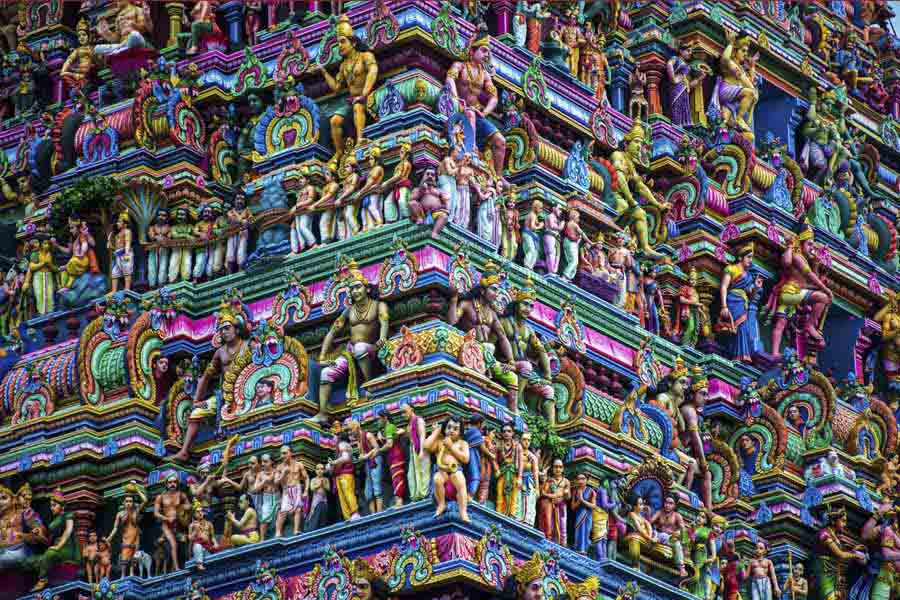|DEFINING WEAVES OF SOUTH INDIA|
| KASAVU | KERALA |
Popularly featured in Raja Ravi Varma’s paintings, women clad in a cotton and gold drape, also known as the famous Kasavu Sarees from the god’s own country, Kerala. When spices were being exchanged for gold, royals saw this as an opportunity to make use of the gold by weaving it into hand-woven saris. Historically, during the reign of Balaramavarma empire, in the 19th century, the Kasavu sarees flourished. “Shaaliyar” weavers community from Nagercoil were imported to Balaramapuram in Kovalam by Maharaja Balaramavarma and his minister Ummini Thampi as they saw an increase in demand for Kasavu saris. The composition of an original Kasavu sari has plain off-white un-dyed cotton with a pure gold zari border. The gold zari is kept soaked in water to soften the thread and to keep it tidy during the weaving process.
TO CHECK THE AUTHENTICITY:
The real zari silk thread generally has a red core yarn, so if you remove a yarn at the end of the tassel and find it to be white, then it is not genuine Kasavu. Alternately, take a coin and rub the Kasavu part of the sari or mundu three or four times. If you find that the rubbed portion is a silver-grey colour, this means that the zari is real. Fakes will reveal black, greenish, blue or other colours.
| MYSORE SILK | KARNATAKA |
The growth of Mysore Silk Saris prospered during the reign of Tipu Sultan in 1785 AD. Maharaja Krishna Raj Wadiyar IV of Mysore opened the first silk factory in 1912 as he saw the humongous potential for machine-made Silk. This factory is now a government enterprise under the name of Karnataka Silk Industries Corporation (KSIC) which exclusively produces Mysore Silk. Karnataka produces 70% of the country’s mulberry silk production, in regions like Channapatna, Ramanagaram, Kanakapura, Magadi in Bangalore and Kollegal in Mysore district. The beauty of a Mysore silk sari lies in the genuineness of the silk (100% fine silk) with pure gold zari (65% silver + 0.65% gold) giving the fabric a natural sheen and rich texture. It is usually produced in a single tone with a gold zari border in vibrant shades like orange, red, green, coffee brown, lilac, and elephant grey. The motifs generally used are paisley motifs, and floral borders in silk, Crepe silk, and Georgette.
TO CHECK THE AUTHENTICITY:
With every Mysore Silk sari, the following details will be embroidered in a corner: History of the sari; Details about its manufacturing; Hours spent on it; Wages received by the weaver.
| PAGAADU BANDHU | ANDHRA PRADESH |
The resist-dyed textiles from the region of Chirala, Andhra Pradesh were called the “Paagadu Bandhu”. Popularly known as Ikat, resist dyeing is a process of weaving where the yarns are dyed in patterns prior to weaving and the pattern emerges when the fabric is woven. Initially, it used to be a full-time activity for the entire family. Koyalagudem and Chautupal regions specializes in Cotton and Silk yardages for furnishings and shirtings, whereas Pochampalli region specializes in silk saris of both single and double Ikat. The very famous Telia Rumal is done in Chirala, used as loincloth by fishermen in earlier times, was dyed in Madder and Alizarin Dye which was treated with oil to give a deeper shade. The patterns used were generally simple geometrics, multicoloured, stripes and chevrons. The weavers were also influenced by Gujarat’s Patola, Orissa Ikat, Japan and Guatemala by exporters and traders. The significant impetus to revival raised at the Festival of India Programmes (1982-1992).
TO CHECK THE AUTHENTICITY:
Ikat saris are easier to spot whether it is original or fake by checking the wrong side of the fabric, where the design is the same as the right side.
| KANJEEVARAM | TAMIL NADU |
The very famous Kanjeevaram saris are timeless marvels dating back to 400 years. Mythology states that Kanchi weavers are descendants of Sage Markanda, who was considered as the master weaver of the god's attire. During the reign of Krishna Devaraya from the Vijayanagar Empire, weaving communities of Andhra Pradesh, the Devangas and Saligars migrated to the town of Kanchipuram. Inspired from the nature and architecture of the Temple Town, the motifs consisted depiction of figurines, peacocks, yalli, rudraksh and annam, with a wide range of variations. The colour combinations include vibrant hues like Mango Yellow with Red, Peacock Blue, Red and Green, and so on. Kanchipuram silk sarees composition has pure mulberry silk which belongs to South India, and the pure gold and silver zari comes from Gujarat. The silk thread that is used to weave the saree is dipped in rice water and sun-dried before it is used in order to increase both, its thickness and stiffness. Korvai, which translates to ‘coherent’ is an exclusive Kanjeevaram technique where the pallu, the border and the body of the saree are woven separately, and then interlocked together.
TO CHECK THE AUTHENTICITY:
Pure zari is made of red silk thread, that is then twisted with a silver thread and dipped in gold. If the zari thread white or any other colour, that isn't an original Kanjeevaram Saree. Another telltale would be the Silk Mark attached with every Kanjeevaram Silk Saree.




